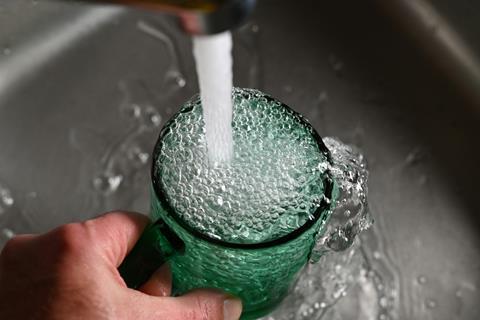Before it even touches our lips, drinking water is purified through a series of processes referred to as the “treatment train” at a centralized treatment plant. Utilities then add a disinfectant like chlorine or chloramine to the water to control the regrowth of microorganisms in both the distribution system and building plumbing.

Despite these treatments, drinking water that meets state and federal regulations still contains many types of bacteria. Though most surviving bacteria are harmless, some like drinking water-associated pathogens (DWPIs), which predominantly impact the immunocompromised, cause more than 145,000 human infections annually and cost the United States billions in healthcare costs.
Sarah Haig, assistant professor of civil and environmental engineering at the University of Pittsburgh Swanson School of Engineering, received a $550,000 Faculty Early Career Development Award from the National Science Foundation (NSF) to learn how some DWPIs can survive drinking water treatment processes and determine better treatment processes to stop them from entering the human body.
According to NSF, the CAREER award is its “most prestigious in support of early-career faculty who have the potential to serve as academic role models in research and education and to lead advances in the mission of their department or organization.”
Lasting collaborations
“Dr. Haig transcends disciplinary boundaries of engineering and biology with ease and has fostered several lasting collaborations in the medical, public health, and civil engineering disciplines here at the University of Pittsburgh,” said Radisav Vidic, Nickolas A. DeCecco Professor and Department Chair of Civil and Environmental Engineering. “In addition to her strengths in research, Dr. Haig is very active in our department’s efforts to develop the curriculum for the undergraduate and graduate environmental engineering program, adding both wet and computer laboratory classes into all of her courses.”
A number of DWPIs are concerning, however, Legionella pneumophila and nontuberculous mycobacteria (NTM) cause the most respiratory infections and cost the greatest amount to treat.
Though the human body can stop these pathogens from entering its system, people with immunosuppressive conditions like cancer, HIV, or preexisting respiratory issues such as COPD have a heightened chance of these pathogens evading their biological defense mechanisms. One possible explanation is the overlap in mechanisms used by these pathogens to evade both drinking water treatment and the human immune system.
Chemical oxidative stress
Disinfection processes kill microorganisms by damaging cells through a process called chemical oxidative stress,” Haig explained. “The human immune system actually uses the same procedure to kill pathogens, but despite these similarities it’s still unknown if the DWPIs that survive oxidative stressors in drinking water treatment are capable of doing the same in someone’s body.
“Basically, my working theory is that low-level antibiotic exposure in the environment helped develop antibiotic resistant ‘superbugs;’ therefore it is possible that DWPIs surviving oxidative stress at the treatment plant may lead to pathogens which are more resistant to the immune system’s pathogen killing mechanisms,” Haig said.
Pilot system
Haig and her team will use a pilot drinking water treatment plant and laboratory-scale systems to find, quantify, and identify how different treatment train and distribution system configurations impact chemical oxidative stress and test what impacts the survival of DWPIs. The completion of this project will create new fundamental knowledge that will guide better drinking water treatment plant design and operations, leading to fewer DWPI infections.
In addition to the scientific contributions of finding solutions to better treat drinking water, Haig’s CAREER award will also help create student education and training opportunities, including the mentoring of one graduate student and one undergraduate at Pitt as well as various K12 activities.
The five-year project, “Drinking water treatment & distribution - the environmental training grounds for pathogens to evade the human immune system,” is set to begin this year.







No comments yet